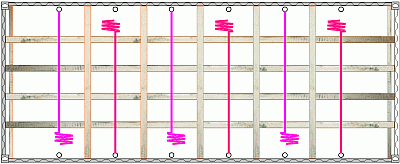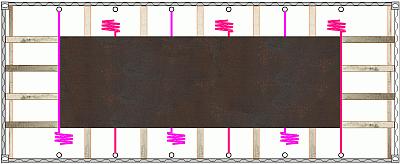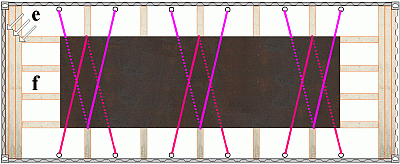 |
|
| Diagram of layout of lashing belts - plan view |
So as not to overload the diagram with details, the strips of friction-enhancing material which would also be laid are not shown.
After the preparatory work, the slab is set down ...
 |
|
| Slab set down on support - plan view |
... and secured laterally with loop lashings.
 |
|
| Slab with sideways tensioned lashings - plan view |
 |
|
| Slabs with tensioned lashings - cross-section |
If webbing belts with a straight-line maximum securing load of approx. 2,500 daN are used, due to the horizontal and vertical lashing angle between the parts, they provide horizontal forces of 2,170 daN per run. This value is calculated from the maximum securing load of 2,500 daN multiplied by the cosine of half the angle between the parts in the vertical axis and multiplied by the cosine of half the angle between the parts in the horizontal axis. Since the lashing points can be subjected to loads of 2,000 daN in all directions and the ends of the loop lashings are attached to separate lashing points, the slab is tightly secured on each side with 6 x 2,000 daN = 12,000 daN. If the friction-enhancing materials are assumed to have a friction coefficient of μ = 0.4, friction forces of approx. 9,400 daN are obtained, while if a friction coefficient of μ = 0.6 is assumed, the friction forces could be as high as approx. 14,100 daN; In the latter case, just two loop lashings per side would then be sufficient.
The slab is braced to prevent lengthwise movement:
 |
|
| Lengthwise bracing of slab - plan view |
To this end, crosspieces (e) are placed against both end walls to distribute pressure and lengthwise wooden members (f) are inserted between these crosspieces and the slab and are nailed to the lattice members beneath.
 |
|
| Lengthwise bracing of slab - cross-section |
The decision as to whether four lengthwise braces are inserted or whether two would be enough or whether smaller lumber could be used is taken on the basis of assumed loads and the estimated coefficient of sliding friction.
If lower mass slabs, which present no problems with regard to line load, are to be carried, the following securing method is very cost-effective with regard to both labor and use of materials.
 |
|
| Extremely cost-effective slab securing - plan view |
Before the slab can be set down from above using webbing slings, an extensive area of the container floor in the area of the four central lashing points is covered with friction-enhancing material at least 10 mm in thickness and the slab is set down on this material so that the webbing slings can be removed from beneath the ends of the slab. (If the webbing slings are thicker than the material beneath the slab, a second layer of friction-enhancing material must be laid.) The single use textile lashing belts are slid beneath the ends of the slab, passed over the slab and tensioned. Lengthwise securing is provided by wooden bracing.
It should be noted in relation to any securing method using webbing belts that edge protectors must always be used with sharp-edged cargoes.